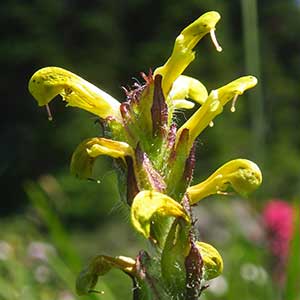Pedicularis attollens
Pedicularis rainierensis
attol lousewort, attoll lousewort, elephant snouts, little elephant head, little elephant's head, woolly Mammoth
Mt. Rainier lousewort
basal 5–25, blade elliptic, 60–150(or 200–250) x 3–23 mm, 1- or 2-pinnatifid, margins of adjacent lobes nonoverlapping, serrate, surfaces glabrous or scattered glands;
cauline 2–20, blade elliptic, 5–50(–100) x 1–5 mm, undivided or 1(or 2)-pinnatifid, margins of adjacent lobes nonoverlapping, serrate, surfaces glabrous.
basal 2–5, blade lanceolate, 40–80 x 3–20 mm, 2-pinnatifid, margins of adjacent lobes nonoverlapping or slightly overlapping distally, serrate to 2-serrate, surfaces glabrous;
cauline 2–6, blade lanceolate, 15–70 x 5–20 mm, 1- or 2-pinnatifid, margins of adjacent lobes nonoverlapping or slightly overlapping distally, serrate, surfaces glabrous.
simple, 1–3, exceeding basal leaves, each 10–50-flowered;
bracts lanceolate to triangular, 5–10 x 3–10 mm, pinnatifid, margins entire, surfaces glabrous or tomentose.
simple, 1–4, exceeding basal leaves, each 10–50-flowered;
bracts lanceolate or subulate to trullate, 10–15 x 1–2 mm, undivided or pinnatifid, proximal margins entire, distal serrate, surfaces glabrous or tomentose.
1.2–1.6 mm.
1–3.5 mm.
calyx 4–5 mm, glabrous or tomentose, lobes 5, triangular, 2–2.5 mm, apex entire, glabrous;
corolla 6–8 mm, tube pink, rarely white, 3–6 mm;
galea white or pink with 2 purple spots or stripes, 1–2 mm, beaked, beak coiled, 3–6 mm, base curving, margins entire medially and distally, apex not surrounded by abaxial lip, axis of coil nearly vertical;
abaxial lip pendulous, white or pink with purple stripe, 4–5.5 mm.
calyx 7.5–11 mm, hispid to tomentose, lobes 5, linear to narrowly triangular, 4–5 mm, apex entire, glabrous or ciliate;
corolla 16–19 mm, tube light or dark yellow, 8–10 mm;
galea light or dark yellow, 8–9 mm, beakless, margins entire medially and distally, apex arching beyond abaxial lip;
abaxial lip light or dark yellow, 4–5 mm.
= 16.
Pedicularis attollens
Pedicularis rainierensis
Subspecies 2 (2 in the flora).
The flowers of Pedicularis attollens, like those of P. groenlandica, resemble an elephant’s head, and A. Heller placed them both in Elephantella. The short, upturned beak, in contrast to the long, more horizontal downturned beak of P. groenlandica, is a distinguishing feature of P. attollens. Whereas P. groenlandica occurs across much of western and arctic North America, P. attollens is found primarily in the Cascade Range of central and southern Oregon and the Sierra Nevada of California and Nevada. It is also reported from the Klamath Range to the west and the White and Sweetwater mountains and the Warner Range to the east of the Sierra Nevada.
(Discussion copyrighted by Flora of North America; reprinted with permission.)
Pedicularis rainierensis is known from Mt. Rainier and the Crystal Mountain area. The species is easily confused with P. bracteosa var. latifolia, which often occurs in the same meadows. While the sizes and shapes of their flowers are nearly indistinguishable, P. rainierensis is a much smaller plant with leaves only about three fourths the size, proximal leaf lobes less than one fifth the size, inflorescences about one half the length, and the number of flowers greatly reduced in comparison to those of P. bracteosa var. latifolia.
(Discussion copyrighted by Flora of North America; reprinted with permission.)
1. Basal leaves 1-pinnatifid. | subsp. attollens |
1. Basal leaves 2-pinnatifid. | subsp. protogyna |


